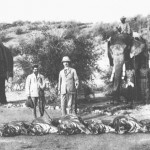Gir National Park: The only abode of Asiatic Lions
Mrs. Shakti & Mr. A S Bishnoi
Gir National Park, also known as Sasan Gir, was established in 1965, with a total area of 1,412 km2, of which 258 km2 is fully protected as National park and 1,153 km2 as wildlife sanctuary. It is part of the Kathiawar-Gir dry deciduous forest landscape. It is also well-known as the last abode of the Asiatic lion.
History:
In the 19th century, the rulers of Indian princely states used to invite the British officers for hunting expeditions. It was seen as a matter of pride to bag a lion. The lion population was fast getting decimated due to the continuous hunting expeditions. By the end of the 19th century lions were exterminated from all other areas except the private hunting grounds of Nawab of Junagarh. The Nawab was tight fisted in granting lion hunting permits as he wanted to save the lions for obtaining favours from the British. So around a dozen lions were the last remaining population in his hunting grounds.
Following a popular outcry in the press in Bombay regarding a proposed plan of Viceroy for hunting lions, the lion hunting virtually stopped and the population slowly started growing back. Today, Gir and its neighbouring areas are the only places in Asia where Asiatic lions occur
There are seven major perennial rivers in the Gir region: Hiran, Shetrunji, Datardi, Shingoda, Machhundri, Godavari and Raval. The four reservoirs of the area are at four dams, one each on Hiran, Machhundri, Raval and Shingoda rivers, including the biggest reservoir in the area, the Kamleshwar Dam, dubbed ‘the lifeline of Gir’.
During peak summer, surface water for wild animals is available at about 300 water points. When drought hits the area following a poor rainfall, surface water is not available at a majority of these points, and water scarcity becomes a serious problem, mainly in the eastern part of the sanctuary. Ensuring the availability of water during peak summer is one of the major tasks of the Forest Department staff.
Our Journey:
Gujarat has different dialects in various regions, Kathiawar, being my personal favourite. I was bought up in Gujarat and I have been fascinated to know about the culture of various places. My good friend Mr Mukesh Jagani is from Saurashtra. So during college days, I had visited this quaint town of Talala, in Junagadh in 2000. I came to know about Asiatic lion and their frequent visit to Mango fields. I was fed with lots of fantastic stories of encounters with the mighty lion. These stories beautifully told and retold several times by my friend and his family members made me curious about the ways of king of the jungle. So we visited his field in the night near the Hiran river cross and sat on machan, a tree house. The first sight of mighty cat with distance of about 5 m was an experience for which I have no words to describe. We were silent and mesmerized even after the male lion left from that place. As we headed back to my friend’s home, he was normal. However, with fear, anxiety, awe, and the many emotions that I was experiencing, my imagination was running wild and concocting stories. Though we reached home soon, the memory of this experience remained alive for a long time.
Years passed and I got married and have a daughter of 7 years. While I was teaching her about animals, she being inquisitive asked several questions and finally it was decided to go on a lion safari again. Soon we headed to my friend’s house in Jan 2020 from Pune. We did not go in my friend’s mango orchards to see the mighty lions, but opted for gypsy safari by forest department.
Gir Sanctuary has the count of 2,375 distinct fauna species about 38 species of mammals, around 300 species of birds, 37 species of reptiles and more than 2,000 species of insects. Gir National Park and Sanctuary does not have a designated area for tourists. However, to reduce the tourism hazard to the wildlife and to promote nature education, an Interpretation Zone has been created at Devalia within the sanctuary. Within its chained fences, it covers all habitat types and wildlife of Gir with its feeding-cum-living cages for the carnivores and a double-gate entry system.
We commenced our journey in an open Gypsy and we were fortunate to see pack of wolves crossing our gypsy followed by Nilgai family(blue bull). Then our much awaited flagship animal, the majestic lion and two lionesses sleeping under a tree was a sight to remember. It was sight to reckon with. Another few meters we saw one mighty lioness walking. Our all dreams came true within minutes. Moving ahead we saw Vulture, spotted owlets and 12 Leopards. The last sighting was again spotted owlet before culmination of our journey.
Gir Lion:
Gir today has 523 asiatic lions as per the 14th Asiatic Lion Census 2015 conducted in May 2015. The population was 411 in 2010 and 359 in 2005. The lion population in Junagadh District was 268 individuals, 44 in Gir Somnath District, 174 in Amreli District, and 37 in Bhavangar District. There are 109 males, 201 females and 213 cubs.
Even though the Gir Forest is well protected, there are instances of Asiatic lions being poached. My friend used to often narrate stories of the forest dwelling Maldhari community poisoning lions for attacking their livestock. Other threats to lions include floods, fires and the possibility of epidemics. But Gir nonetheless still remains the only preserve for lions.
There are ‘The Cat Women of Gir Forest’ who assist forest depart in counting and also generate awareness in the local populace especially younger lots for conservation and to avoid poaching. We even went to Kamleshwar Dam and nearby bird sites and manage to capture them in our camera. Gir is an excellent places for bird lovers.
Some Interesting Lion facts:
Since Gir is the only abode of lions in India, it is a major attention of tourists and wildlife enthusiasts.
(a) A limited number of lions live in India – Whereas India is the only home for wild Asiatic lions, a greater number of wild lions live in Sub-Saharan Africa. Asiatic Lions and African lions are different species.
(b) In comparison to African lions, Asiatic lions are smaller in size.
(c) Lions are the only wild cats that prefer to live in a group known as pride.
Life of Asiatic Lions is 18-20 years.
(d) The average life of Asiatic Lion ranges in 15 to 16 years but many of them become old after crossing 9 or 10 years of their life. Nearly 30% deaths are caused by unnatural causes like electrocution or being hit by speedy vehicles or trains. 60% of Asiatic lions die due to natural causes. Few Lions in the area have drowned in open wells of villages.
Concern: Conservation of Asiatic lions:
Despite the 500+ numbers shown up in the census, Asiatic lions are in danger of getting extinct as they are all concentrated in one landscape. One single epidemic can wipe away the entire population. So a second home for the Asiatic lion is important to save the species.
Gir Sanctuary, Pania Sanctuary, Gir National Park forms the Gir Conservation Area (GCA) which currently exists to protect the Asiatic lions in the wildlife reserve. Mitiyala and Girnar are the other two wildlife sanctuaries which protects satellite areas within the dispersal distance of GCA. Another sanctuary is being established near Barda Forest to serve as an alternative home for Gir Asiatic Lions. The plan to shift a few lions to Kuno-palpur in Madhya Pradesh to create an alternate home for lions have been stopped by Gujarat, despite the Supreme Court of India giving it the go ahead several years ago. Gujarat doesn’t want to share lions with any other states as Gujarat wants to be known as the only state to have lions.
In the last two decades I have seen drastic change in the topography in and around Gir. The local people have shifted focus from agriculture for easy money. Hotel industry is coming up with good number of buildings on high-way and offering the grand view of Gir and also promising sure shot sighting of lions. Hoteliers are eyeing good business opportunities around Gir sanctuary and people are selling land for easy gain and more money. This move will have long term effect on lions of Gir. Govt should take action and stop construction of so called “Jungle Resorts” in and around Sanctuary so that the lions can stay in peace. Otherwise Asiatic Lions will soon need to be shifted to preserve them.
Due to the tourism industry led rampant construction of hotels and guest house, the vehicular traffic has increased. Since the road connecting Talala and Junagadh pass through Sanctuary, it causes disturbance and is a threat to the lions. Even though tourism is limping due to Covid 19 pandemic, normalcy is in sight now and tourism traffic is expected to rebound in the next few months. In the coming few months and years this problem will aggravate. We need to take action now to preserve the sanctuary as this is the only place in Asia where lions live.
- Ladakh: An Enchanting Landscape - 28 June,2022
- Changes observed during a decade long love affair with Chilika - 31 March,2022
- Journey to Leopard Country - 30 December,2021

















Leave a Reply